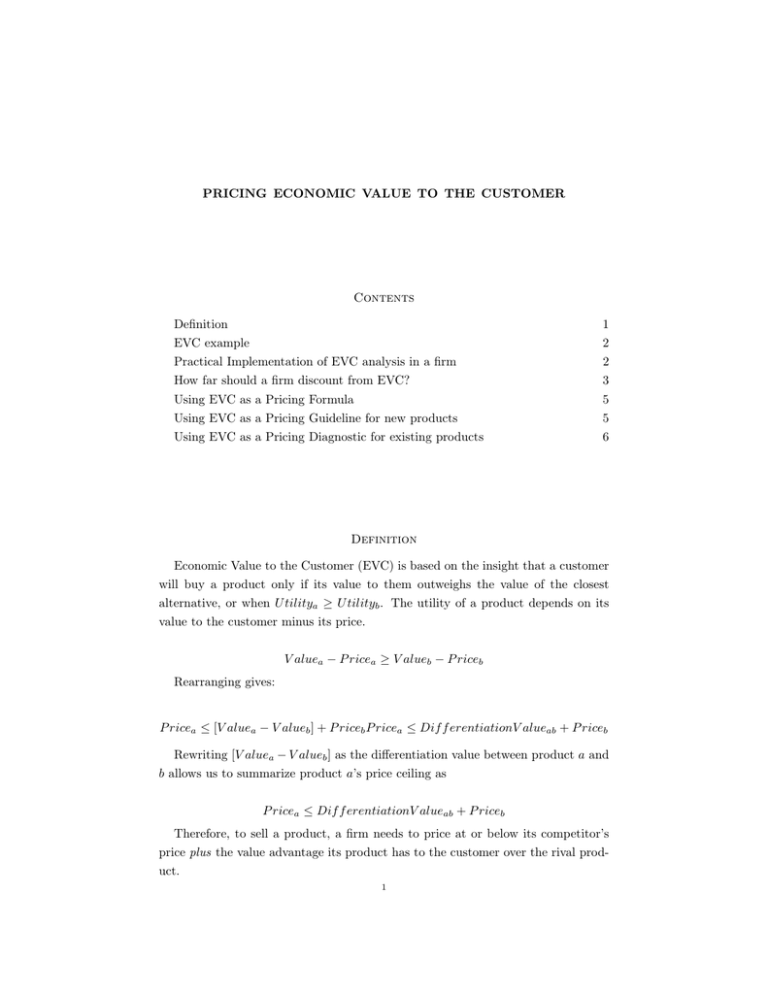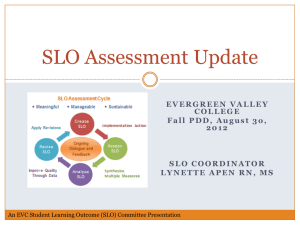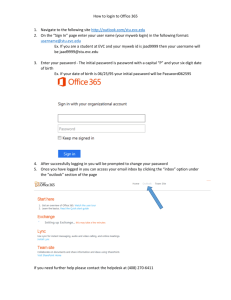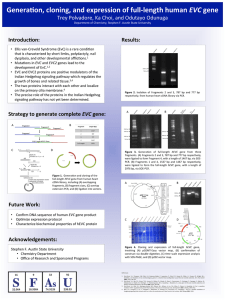PRICING ECONOMIC VALUE TO THE ... Contents Definition 1
advertisement

PRICING ECONOMIC VALUE TO THE CUSTOMER Contents Definition EVC example Practical Implementation of EVC analysis in a firm How far should a firm discount from EVC? 1 2 2 3 Using EVC as a Pricing Formula Using EVC as a Pricing Guideline for new products 5 5 Using EVC as a Pricing Diagnostic for existing products 6 Definition Economic Value to the Customer (EVC) is based on the insight that a customer will buy a product only if its value to them outweighs the value of the closest alternative, or when U tilitya ≥ U tilityb . The utility of a product depends on its value to the customer minus its price. V aluea − P ricea ≥ V alueb − P riceb Rearranging gives: P ricea ≤ [V aluea − V alueb ] + P riceb P ricea ≤ Dif f erentiationV alueab + P riceb Rewriting [V aluea − V alueb ] as the differentiation value between product a and b allows us to summarize product a’s price ceiling as P ricea ≤ Dif f erentiationV alueab + P riceb Therefore, to sell a product, a firm needs to price at or below its competitor’s price plus the value advantage its product has to the customer over the rival prod­ uct. 1 2 PRICING ECONOMIC VALUE TO THE CUSTOMER EVC example Atlantic Computer has developed software that allows their servers to host twice as much webspace as its rivals. How should they price this new software-server combination? • Relative to buying two servers from Atlantic’s competitor, by buying one doubly efficient server from Atlantic, a firm would save $4,000 in labor costs, $500 in electricity and $1,500 in software licenses. This suggests that the differentiation value relative to the closest competitive offering is $6,000. • The price of two servers from the competitor is $6,800. • This suggests that the EVC of a server with the software is $6,000 + $6,800 = $12,800. Practical Implementation of EVC analysis in a firm • Identify what benefit your product provides – Make sure you define a benefit, not a feature. Skill here reaps large rewards. ∗ Xerox became very profitable because it priced per photocopy. • Identify closest competitive offering and calculate its price – Be honest about who your closest competitor is ∗ For example, even though a B2B online video-calling service may want to compare itself to dedicated-line video-conferencing systems, its real closest competitor is Skype, which is free. – Be honest with yourself about the price that competitors sell their product for. ∗ For example, a web back-up company calculated an EVC price that was 100 percent greater than what they were charging. However, they omitted to include the fact that all their rivals discounted at 80 percent from list. – Get the units and time-horizon right. This is far easier to do when you have defined the product’s benefit properly. ∗ For example, an cleaning product manufacturer left money on the table by not reflecting the fact that its cleaner cleaned twice as much as its competitor. • Identify potential sources of differentiation value – Be specific, not vague. It is important that your firm’s value proposi­ tion does not sound like it was churned out by generic software. • Measure how much value these create – Have an independent lab do measurable testing. PRICING ECONOMIC VALUE TO THE CUSTOMER 3 ∗ For example, an air-filter company got a lab to measure the number of dust particles in the air and estimate the effect this would have on asthma sufferers. – Often current customers are willing to take part in benchmarking stud­ ies, as they view it as free consulting. ∗ For example, W.W. Grainger offered consulting and measure­ ment incentives to 15 clients who agreed to participate. • Add the reference price and differentiation values together to get EVC. The next challenge is to determine how far below EVC the firm’s ideal price point will be. How far should a firm discount from EVC? It is a common misperception that EVC analysis implies that a firm should price at the EVC. This is not the case. The EVC describes only the maximum price a firm might theoretically charge. Generally, a firm will decide to forego some of their differentiation value.1 There is some neurological basis for this ‘fairness effect’.2 You’re standing on the sidewalk with a friend, minding your own business, when a man approaches with a proposition. He offers you $20 in one-dollar bills and says you can keep the money, under one condition: You have to share some of it with another person. You can offer this other person as much or as little as you like, but if they reject your offer, neither of you get to keep any of the money. What do you do? This suggests a 50 percent discount rule. • For example, Atlantic Computer ultimately priced not at the suggested EVC, but instead discounted its differentiation value by 50 percent ($3,000), so that it priced the product at $9,800. Set price closer to EVC if. (1) End-Benefit effect: When your product is an essential part of a known end-use. • Since Bridal Bouquets are a small but essential part of a large and expensive end product, florists are able to charge a great deal more for them than for other bouquets. (2) Shared-Cost effect: When the cost is shared. 1Sloan Management Review ‘Why the Highest Price Isn’t the Best Price’, Winter 2010. 2‘The Neural Basis of Economic Decision-Making in the Ultimatum Game’, Science 13, June 2003. 4 PRICING ECONOMIC VALUE TO THE CUSTOMER • Business hotels have been able to capture the customer’s differentiation value for pillow-top mattresses and expensive bedding because usually the firm is paying for the hotel stay. (3) Advantageous mental account: Customers have different mental accounts which they evaluate separately when they make purchase decisions. Price closer to EVC if your product falls into an advantageous mental account such as ‘Vacation Money’ or ‘Tax Refund Money’. • For example, success of travel agency selling Las Vegas packages that offered a $300 tax rebate special to coincide with the 2008 Bush tax rebate checks. May have to price well below EVC if. (1) Uncertainty Effect: Uncertainty over realization of attributes • For example, a new anti-dandruff shampoo was unable to command a price premium because its claims could not be verified by experts and consumers knew that its effectiveness would vary. (2) Newness Effect: Attributes are new and therefore hard to understand • For example, Boxee is a ‘freeware cross-platform media center software with social networking features that is a fork of the open source XBMC media center software with some custom and proprietary additions’. Since customers are unlikely to understand the value that implies, they may have to price below EVC when they release their hardware (allegedly) in 2010. • Make clear this is temporary. 1969 study: Five brands in two stores. One had discount from initial price, other had no sign of discount. In all five cases, the store that had marked the discount as being from the list price did better in the long run. (3) Expenditure effect: When it is a larger proportion of expenditure. • For example, an industrial carpet cleaner could charge higher prices to office managers than dedicated office cleaning companies. (4) When it is ethically right or legally appropriate to do so • Bottled water priced at $35 for a 12 pack during Hurricane Rita • North Carolina ‘Price Gouging Law’. North Carolina defines price gouging as intentionally charging an unreasonably excessive price un­ der the circumstances for goods or services that are used by North Carolinians during an emergency to preserve, protect or sustain life, health, safety or economic well-being. May wish to price below EVC for strategic reasons if. (1) Winner-takes-all market PRICING ECONOMIC VALUE TO THE CUSTOMER 5 (2) Initial Customer Lock-In (3) Pre-empt competitive response We discuss these in detail in weeks 3-6 of the course. There are three ways that EVC analysis gets used (as a formula, as a guideline and as a diagnostic), which we now discuss in turn. Using EVC as a Pricing Formula It is best to use EVC as a pricing formula • When competitor’s prices are well-known and concrete • When a product’s differentiation value is easy to calibrate • When a product’s differentiation value is easy and believable to communi­ cate The Atlantic Computing example is an almost ideal setting for the use of EVC as a formula. The ideal setting for the use of EVC as a formula is one where the seller knows precisely how the customer will use the product, and intimate details of their likely cost savings or net benefits of using the technology. This generally implies a man­ ufacturing or engineering setting. This is no surprise, since consultants developed EVC analysis for these kind of industries. EVC can be particularly useful as a tool to help the sales force sell and prevent price erosion by allowing them to answer questions like: • How can you justify charging that much for your product? • Why should I buy your product when your competitor’s product is $3,000 cheaper? • What is most worthwhile for our firm to keep in mind about your offering? However, the system should not be so complex that sales people bypass it. Using EVC as a Pricing Guideline for new products EVC can be useful for a firm that is choosing the initial price of its product. The classic example of this is Zantac. As a second entrant to the stomach ulcer market, it may have been natural for them to price at or just under the incumbent’s (Tagamet’s) price. However, EVC analysis demonstrated large differentiation value because of the twice-daily dosage format and fewer side effects, and as a consequence they priced at 50 percent above the incumbent’s price. In two years they were the market leader. 6 PRICING ECONOMIC VALUE TO THE CUSTOMER Using EVC as a Pricing Diagnostic for existing products EVC is a useful tool for establishing whether an existing product that is per­ forming poorly is overpriced or mis-promoted (1) Overpriced • Segway recognized that compared to its EVC, segways were felt by the majority of customers to be overpriced at a price point of $3,000. Therefore the Segway company focused on finding ways of reducing the average price, such as the use of Segway on one-day city tours. (2) Value message is not focused on crucial differentiation value • Michelin initially emphasized all its points of differentiation value such as longevity, speed and safety, in its advertising. Customer tests re­ vealed that their most salient and easy to communicate differentiation value was safety, and Michelin switched its advertising to emphasize that, with great success. (3) Value message is not being communicated effectively • Duracell found out that its value message that it lasted for longer was not believed by customers. Therefore they switched from a quan­ titative message to one that emphasized that consumers should use Duracell batteries when reliability was crucial. It is essential to conduct a form of EVC analysis before instituting a price cut, to protect management from making the wrong decision. MIT OpenCourseWare http://ocw.mit.edu 15.818 Pricing Spring 2010 For information about citing these materials or our Terms of Use, visit: http://ocw.mit.edu/terms.


